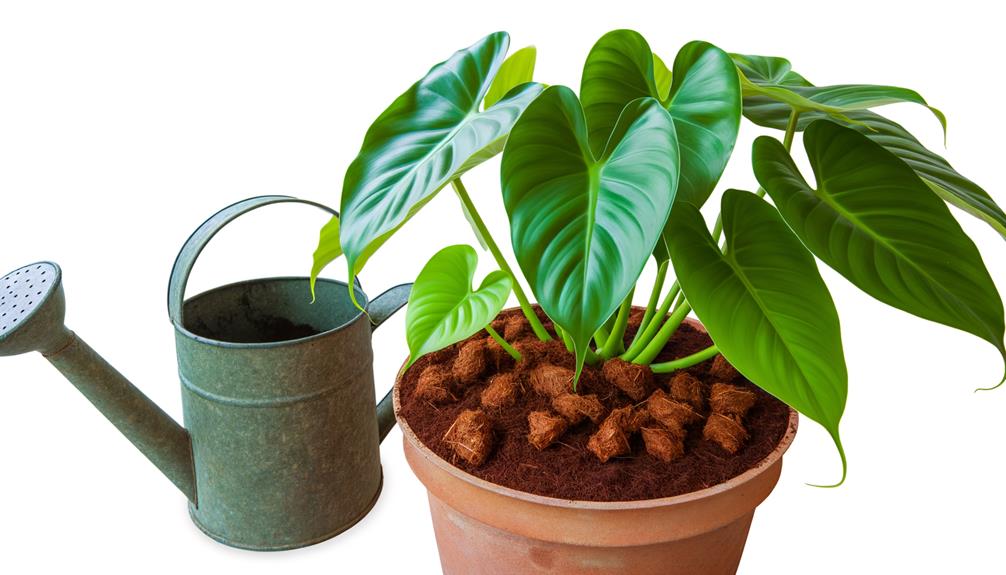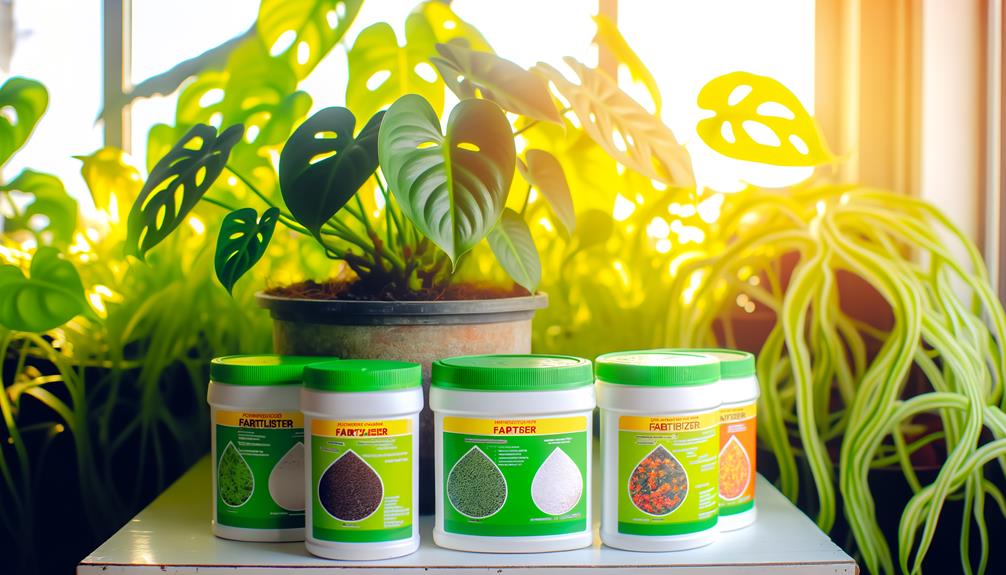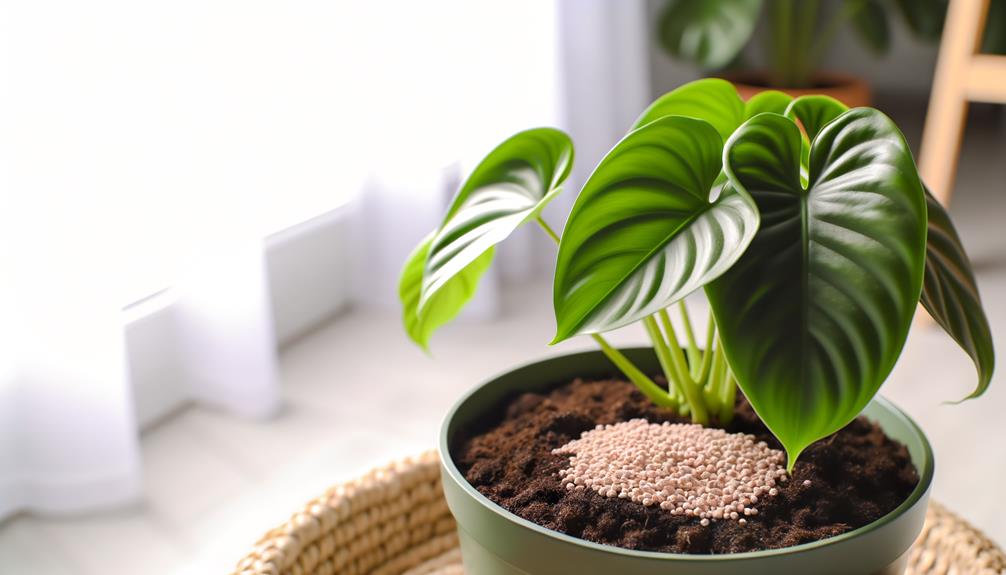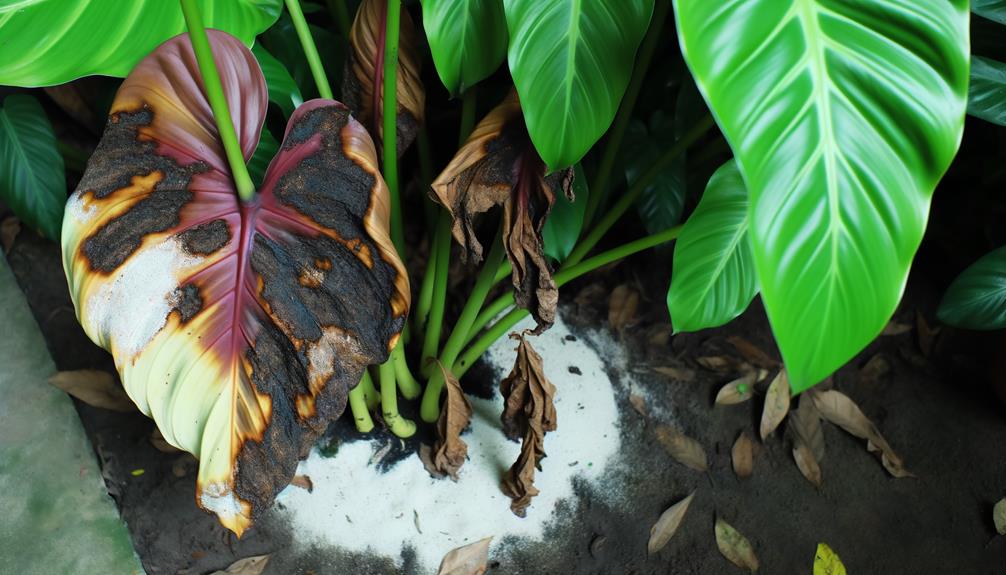What Is the Best Fertilizer for a Heartleaf Philodendron?
The best fertilizer for a Heartleaf Philodendron is a balanced, water-soluble fertilizer with an N-P-K ratio of 20-20-20. Apply bi-weekly at half the recommended strength to avoid root burn.
This guarantees a steady supply of nitrogen, phosphorus, and potassium, essential for foliar, root, and cellular health, respectively. Liquid fertilizers are preferred for their direct delivery to roots.
Adjust fertilization to every 6-8 weeks during winter with a 10-10-10 formula. Monitor for signs of over-fertilization like leaf burn and stunted growth.
Brands like Miracle-Gro Indoor Plant Food and Dyna-Gro Grow are ideal. For more detailed guidance, explore additional recommendations.

Key Takeaways
- Use a balanced, water-soluble fertilizer with an N-P-K ratio of 20-20-20 for bi-weekly applications.
- Dilute liquid fertilizers to half strength to prevent root burn during the growing season.
- Apply granular fertilizers for slow-release nutrient availability and even distribution on the soil surface.
- Choose organic fertilizers like Espoma Organic Indoor Plant Food for a slow and environmentally friendly nutrient release.
- Adjust fertilization frequency to once every 6-8 weeks during winter using a balanced 10-10-10 fertilizer.
Understanding Nutrient Needs

Understanding the nutrient needs of a Heartleaf Philodendron is fundamental for promoting ideal growth and maintaining its vibrant foliage.
This tropical plant primarily requires nitrogen, phosphorus, and potassium, commonly represented as N-P-K on fertilizer labels.
Nitrogen is important for foliar development, enhancing the lush, green appearance of the leaves.
Phosphorus supports root growth and flower development, while potassium aids in overall cellular functions and stress resistance.
Additionally, micronutrients such as calcium, magnesium, and iron play essential roles in enzymatic activities and chlorophyll synthesis.
Regularly monitoring soil pH, which should ideally be slightly acidic to neutral (pH 5.5-7.0), ensures optimal nutrient absorption.
Meeting these nutritional needs will result in a robust and aesthetically pleasing Heartleaf Philodendron.
Organic Vs. Synthetic Fertilizers
Choosing between organic and synthetic fertilizers for a Heartleaf Philodendron involves evaluating their nutrient release rates, environmental impact, and potential effects on soil health. Organic fertilizers, derived from natural sources, release nutrients slowly, promoting sustained plant growth and enhancing soil structure. Conversely, synthetic fertilizers offer immediate nutrient availability, which can be advantageous for rapid growth but potentially harmful to soil microorganisms over time.
| Aspect | Organic Fertilizers | Synthetic Fertilizers |
|---|---|---|
| Nutrient Release | Slow and steady | Immediate and fast |
| Environmental Impact | Low; environmentally friendly | Potential pollution issues |
| Soil Health | Improves soil structure and health | May degrade soil quality long-term |
| Cost | Generally higher | Typically lower |
Understanding these differences helps in making an informed choice tailored to specific plant care goals and environmental considerations.
Balanced Fertilizers Explained

In addition to weighing organic versus synthetic options, it is important to understand the role of balanced fertilizers. These fertilizers provide a uniform ratio of essential nutrients such as nitrogen, phosphorus, and potassium critical for the overall health and growth of a Heartleaf Philodendron. Balanced fertilizers are typically labeled with an N-P-K ratio, such as 10-10-10, indicating 10% each of nitrogen, phosphorus, and potassium.
Nitrogen promotes lush foliage, phosphorus supports strong root development, and potassium enhances overall plant vigor and disease resistance. For best results, applying a balanced fertilizer during the growing season ensures that the Heartleaf Philodendron receives a consistent supply of these essential nutrients, thereby facilitating robust growth and vibrant leaves.
Liquid Fertilizers
Liquid fertilizers offer a convenient and efficient method for delivering necessary nutrients directly to the roots of a Heartleaf Philodendron, ensuring rapid uptake and immediate benefits for the plant's health and growth.
These formulations typically contain a balanced mix of nitrogen, phosphorus, and potassium (N-P-K), along with trace elements like iron and magnesium, essential for photosynthesis and cellular function.
When applying liquid fertilizers, dilute the solution to half the recommended strength to prevent nutrient burn. Administer the fertilizer every 4-6 weeks during the growing season, ensuring even distribution around the root zone.
This approach enhances nutrient absorption, promotes robust foliage, and supports overall plant health. Regular monitoring of soil moisture will further optimize the effectiveness of liquid fertilizers.
Granular Fertilizers

While liquid fertilizers provide immediate nutrient availability, granular fertilizers offer a slow-release option that can sustain a Heartleaf Philodendron's nutrient needs over an extended period.
Granular fertilizers consist of nutrient-rich particles that gradually dissolve in the soil, ensuring a steady supply of essential macronutrients like nitrogen (N), phosphorus (P), and potassium (K).
To apply, evenly distribute the granules on the soil surface, avoiding direct contact with the plant stem to prevent root burn. Water thoroughly to activate the nutrients. This method reduces the need for frequent fertilization and minimizes the risk of over-fertilizing.
For best results, choose a balanced granular formulation, such as a 10-10-10 or 14-14-14 NPK ratio, tailored for indoor foliage plants.
Slow-Release Options
Slow-discharge fertilizers represent an effective method for maintaining consistent nutrient availability to a Heartleaf Philodendron. They gradually release nutrients over an extended period, reducing the frequency of applications and minimizing nutrient leaching.
These fertilizers often come in the form of coated granules or spikes embedded with essential macronutrients like nitrogen (N), phosphorus (P), and potassium (K), as well as trace elements. The encapsulation technology ensures a controlled release, correlating with soil moisture and temperature conditions.
This method is particularly advantageous for indoor plants, where over-fertilization and nutrient runoff can be concerns. For best results, select a slow-discharge fertilizer with a balanced N-P-K ratio, preferably 20-20-20, to support overall growth and foliage health.
Fertilizer Application Tips

To effectively apply fertilizer to a Heartleaf Philodendron, first make certain the soil is adequately moist to prevent root burn and facilitate nutrient absorption.
Best application involves using a balanced, water-soluble fertilizer with an N-P-K ratio of 20-20-20. Dilute the fertilizer to half the recommended strength, as excessive nutrients can lead to phytotoxicity.
Administer the solution evenly around the root zone, guaranteeing it reaches the entire root system. Avoid direct contact with foliage, which can cause foliar burn.
Incorporate the fertilizer into the watering routine, typically once every 4-6 weeks. After application, monitor the plant for any signs of nutrient deficiency or excess, adjusting the frequency accordingly. This guarantees sustained, healthy growth without over-fertilization.
Seasonal Fertilizing Guide
Understanding the seasonal fertilizing needs of a Heartleaf Philodendron is important for best growth and health.
In spring, a high-nitrogen fertilizer supports strong new growth, while summer requires balanced nutrients to maintain vigor.
During winter, it's advisable to reduce fertilization to prevent nutrient buildup, as the plant's metabolic rate slows.
Spring Growth Boost
As the Heartleaf Philodendron awakens from its winter dormancy, it is important to provide an essential nutrient boost through a well-balanced fertilizer to support vigorous spring growth. A fertilizer with a balanced N-P-K ratio, such as 20-20-20, is recommended for best growth. Nitrogen (N) promotes lush foliage, phosphorus (P) strengthens root systems, and potassium (K) enhances overall plant health.
| Nutrient | Function | Source |
|---|---|---|
| Nitrogen | Foliage development | Ammonium nitrate, urea |
| Phosphorus | Root growth | Superphosphate, bone meal |
| Potassium | Disease resistance | Potassium sulfate, kelp |
Apply the fertilizer every 4-6 weeks during the spring season, ensuring the soil is moist to prevent root burn. Regular fertilization encourages robust leaf production and overall health.
Summer Nutrient Needs
During the summer months, it is crucial to adjust the fertilizing regimen for the Heartleaf Philodendron, focusing on maintaining nutrient levels to support continuous growth and resilience against higher temperatures.
Utilize a balanced, water-soluble fertilizer with an N-P-K ratio of 20-20-20, applied bi-weekly. Verify the solution is diluted to half the recommended strength to prevent root burn.
The elevated temperatures and increased light intensity accelerate metabolic processes, necessitating supplemental micronutrients such as magnesium and iron. Monitor soil moisture closely, as rapid evaporation may lead to nutrient imbalances.
Incorporating a slow-release fertilizer can provide a steady nutrient supply, reducing the risk of over-fertilization. This approach guarantees the plant remains vigorous and lush throughout the demanding summer season.
Winter Fertilizing Tips
Winter fertilizing for a Heartleaf Philodendron should focus on reducing nutrient application to account for the plant's slowed metabolic rate during the colder months. During winter, the plant's growth diminishes, making it essential to adjust fertilization practices accordingly.
Consider the following guidelines:
- Frequency: Decrease fertilization to once every 6-8 weeks, as opposed to the bi-weekly applications typical in growing seasons.
- Strength: Dilute the fertilizer to half its usual potency to prevent nutrient accumulation and potential root damage.
- Type: Opt for a balanced, water-soluble fertilizer with an equal ratio of nitrogen, phosphorus, and potassium (e.g., 10-10-10) to maintain essential nutrient availability without overstimulation.
Adhering to these practices guarantees the Heartleaf Philodendron remains healthy and prepared for robust growth in the spring.
Signs of Over-Fertilization

Excessive fertilizer application can manifest in heartleaf philodendrons as leaf burn, characterized by yellowing or browning leaf edges and tips.
Osmotic stress from high salt concentrations in the soil may lead to root damage, impairing the plant's ability to uptake water and nutrients.
Other symptoms include stunted growth, wilting, and an accumulation of white, crusty residue on the soil surface.
To mitigate these issues, it is essential to adhere to recommended fertilizer dosages and conduct periodic soil leaching to flush out excess salts.
Monitoring the plant's response to fertilization and adjusting the schedule accordingly can help maintain best health.
Employing a balanced, water-soluble fertilizer at half-strength during active growth phases is advisable for sustaining vigor.
Best Brands to Consider
To maximize health and growth for your heartleaf philodendron while avoiding the pitfalls of over-fertilization, selecting a reliable and appropriate fertilizer brand becomes crucial. For top-notch results, consider the following brands:
- Miracle-Gro Indoor Plant Food: This water-soluble fertilizer provides essential nutrients, ensuring balanced nutrition and promoting lush foliage.
- Espoma Organic Indoor Plant Food: Comprised of natural ingredients, this liquid concentrate feeds slowly, minimizing the risk of nutrient burn and supporting sustainable growth.
- Dyna-Gro Grow: With a complete nutrient profile, including micronutrients, this liquid fertilizer supports robust root development and overall plant vitality.
Each of these brands offers specific benefits that cater to the nutritional needs of heartleaf philodendron, ensuring a thriving and vibrant plant.
Conclusion
To wrap it up, choosing the best fertilizer for a heartleaf philodendron necessitates a thorough understanding of the plant's nutrient requirements, the distinctions between organic and synthetic choices, and the benefits of balanced mixtures.
Using liquid or granular fertilizers wisely, following seasonal recommendations, can greatly improve plant health.
Identifying signs of over-fertilization is essential to prevent harmful outcomes. As the proverb goes, 'the proof of the pudding is in the tasting,' and opting for reputable brands can guarantee strong growth and vigor.






